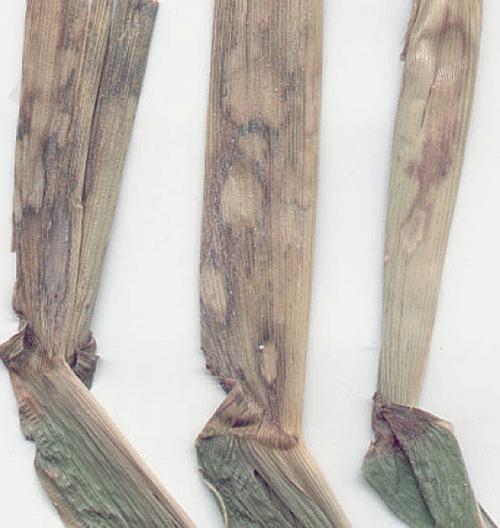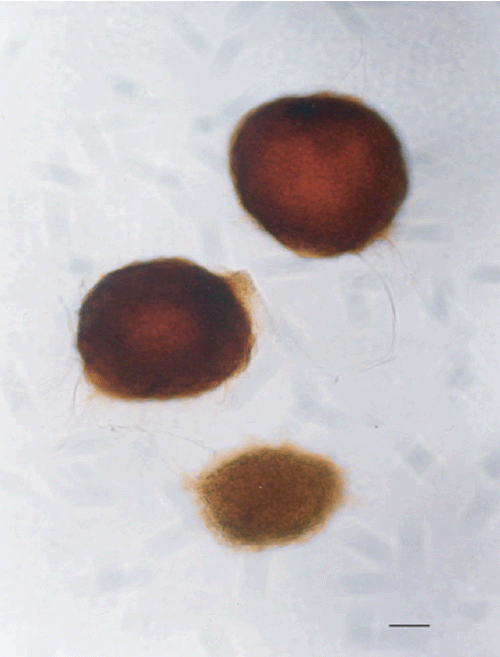First record of Rhizoctonia zeae on corn in Argentina
S. A. Gutiérrez A C , M. A. Cúndom A , V. Barrera B and L. Gasoni BA Cátedra de Fitopatología, Facultad de Ciencias Agrarias, Universidad Nacional del Nordeste, Sargento Cabral 2131 (3400), Corrientes, Argentina.
B Instituto de Microbiología y Zoología Agrícola, Instituto Nacional de Tecnología Agropecuaria, C.C. 25 (1712) Castelar, Buenos Aires, Argentina.
C Corresponding author. Email: suarroz@yahoo.com.ar
Australasian Plant Disease Notes 2(1) 137-138 https://doi.org/10.1071/DN07054
Submitted: 17 June 2007 Accepted: 4 September 2007 Published: 19 September 2007
Abstract
Rhizoctonia zeae was recorded for the first time in sheath leaves of corn in Corrientes Province, Argentina.
During 2004–2006 plants of corn (Zea mays) exhibiting disease symptoms on the sheaths were observed in commercial crops in Empedrado and Santo Tome, Corrientes Province, Argentina. Symptoms were associated with a species of Rhizoctonia. Possible records of the abnormality observed were not found in Argentine literature. This work was done to identify the aetiology of this new disease damaging Z. mays in Argentina. The study was carried out in the Laboratories of Plant Pathology, Faculty of Agronomy, National University of North East (UNNE) (Corrientes Prov.) and the National Institute of Agricultural Technology (INTA) Castelar, Buenos Aires Prov., Argentina.
Diseased tissue was surface sterilised for 1 min in 2.5% NaOCl and plated on potato glucose agar (PGA) at 1.5%, pH 6.5. A common fungus was isolated and hyphal tips were transferred to new plates. Morphological and cultural characteristics of the isolates were determined on PGA. The number of nuclei was determined by counting vegetative cells stained in 1% acridine orange solution. The anastomosis group was tested by growing the isolates with a standard strain of R. zeae, M009, on 2% water agar (WA). The hyphal fusion percentage was estimated according to Sneh et al. (1991).
Pathogenicity of two isolates was determined by inoculating sheaths of corn with mycelial plugs of fungi, with and without injuries, in corn plants growing in pots in a greenhouse at 25–30°C. The respective control plants were taken as reference. The plants were covered with plastic bags for the first 72 h after inoculation.
The symptoms observed were spots on the sheaths of flowering corn plants. At the beginning, uncoloured areas were observed, with elliptical and irregular shaped lesions with greenish grey, white or brown edges surrounded by a soft lighter halo. When lesion development was complete, they acquired a greyish colour with well developed dark brown edges. Lesions covered part or all of the width of the sheath. The fusion of the spots produced extensive necrosis of the sheaths (Fig. 1).

|
In all the studied samples, the presence of a Rhizoctonia fungus was confirmed and this was identified as Rhizoctonia zeae on the basis of hyphal and colony morphology, nuclear condition and anastomosis reaction.
Colonies were orange when young, becoming salmon coloured with age. Sclerotia formed both on the agar surface or were submerged in the medium and were mostly 0.5 to 1 mm in diameter, irregularly spherical, whitish when young, then pinkish orange to reddish brown when mature (Fig. 2). On PGA, the fungus formed septate vegetative hyphae, typically constricted at right angles. Cells were multinucleate and 80% hyphal fusions with a R. zeae tester strain was observed.

|
The pathogenicity tests were positive, reproducing the symptoms observed in natural conditions. Disease symptoms were observed 1 week after inoculation. Control plants grown in pots did not develop symptoms. The fungus was reisolated from the diseased tissues thus confirming Koch’s postulates. The isolates were deposited in the fungal collection of the Laboratory of Plant Pathology, Faculty of Agronomy (UNNE).
The disease caused by R. zeae was described for the first time by Voorhees in Florida, as sclerotial rot of corn (Voorhees 1934). In the State of Pará, Brazil, R. zeae was detected causing corn rot (Poltronieri et al. 2002). In the USA, the fungus has been reported to cause diseases of several turfgrass species (Smiley et al. 2005), which have been called hot weather brown patch, leaf and sheath spot, rot, blight or brown ring patch among others. To our knowledge, this is the first finding of Rhizoctonia zeae causing sheath spot in corn crops in Argentina.
Poltronieri LS,
Trindade DR, Albuquerque F
(2002) Rhizoctonia zeae causando podridão em milho no Estado do Pará. Fitopatologia Brasileira 27, 423.

Voorhees RK
(1934) Sclerotial rot of corn caused by Rhizoctonia zeae. Phytopathology 24, 1290–1303.



